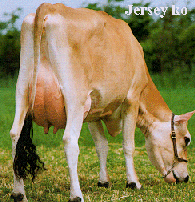Distribution curves for fat-% in the milk for HF (Holstein Frisian) and Jersey. For Jersey both year 1900 and 1990.


|
Figure 1.6. Distribution curves for fat-% in the milk for HF (Holstein Frisian) and Jersey. For Jersey both year 1900 and 1990. 
|

|
The effect of animal breeding is shown in Figure 1.6. This gives an understanding of how the breeding
work has affected the fat-% in the milk from the Danish Jersey dairy breed. Over the last 20 generations animals with the highest fat-%
in the milk have been selected for breeding. The effect of this selection has been
an increase by 0.1 units in the fat-% per generation. Nothing indicates that it
would impossible to continue
for the next 20 generations
with the same effect of selection to gain a higher fat content in the milk. Or
whether it is desirable by selection to return to the
starting point. The HF has not been selected for fat-% and has therefore
been fairly stable with respect to the fat-% in the milk during the same
period.
Figure 1.7.
|
Figure 1.7 shows a drawing from Science Nov. 1990. The drawing indicates that evolution is a simple principle in which each animal adapts to the challenges of the environment. Evolution is not the individual animals' ability to adapt, but the fact that the best adapted animals give birth to a larger number of well adapted offspring, therefore new individuals which are even better adapted occurs in each new generation
Both animal breeding and natural selection are slow processes. But with strong selection a population can change the average value with up to 10 % per generation, if the given trait has a high degree of heritability.
Results of continued selection for litter size in mice through 30 generations can be seen here. By selection in this period the litter size has been increased by 5 young per litter, from 9 to 14. This corresponds to an increase in litter size of 0.16 young per generation.